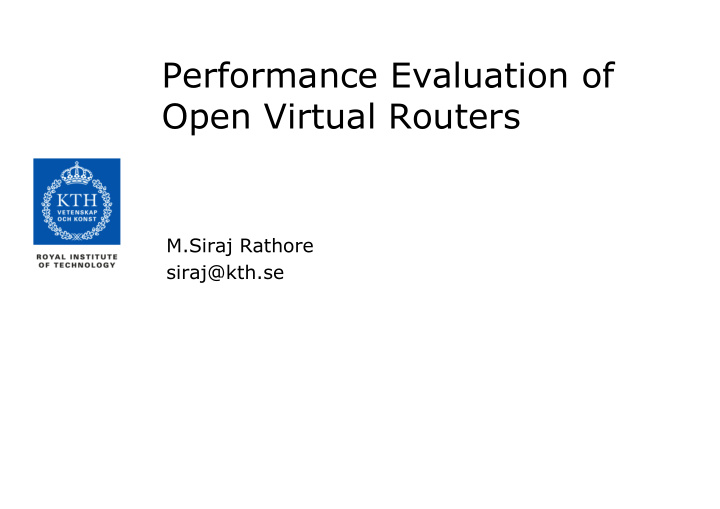



Performance Evaluation of Open Virtual Routers M.Siraj Rathore siraj@kth.se
Outline • Network Virtualization • PC based Virtual Routers • Challenges • Virtual Router Design • Performance Evaluation • Conclusion
Network Virtualization • A solution to provide network researchers to run experiments on a shared substrate network • Network virtualization means to virtualize all network components ( Hosts, Links and Routers) • A major challenge is to virtualize the actual network elements, Switches and Routers
Open Virtual Routers • Commodity hardware, Open source softwares • Run multiple independent virtual instances in parallel on the same hardware • A virtualization technology enforces resource limiting among virtual routers • Each virtual router maintains its own set of virtual network interfaces, protocols, routing tables, packet filtering rules (i.e. separate data and control planes)
Challenge • Router virtualization is associate with performance penalties • Virtualization overhead is introduced in terms of how packets are processed in the router • How to combine software modules to form an open virtual router with minimum virtualization penalty
Linux Virtual Routers
Virtualization Technologies • Hypervisor: It runs on top of the physical hardware and it virtualizes hardware resources to be shard among multiple guest operating systems E.g. VMware, Xen • Container: The operating system resources are virtualized (e.g. files, system libraries) to create multiple isolated execution environment on top of a single operating system. E.g. OpenVZ, Linux Namespaces
OpenVZ based Virtual Routers • Virtual devices Virtual Network Device (venet): Operates at layer 3. An IP address is local and unknown from external networks Virtual Ethernet Device(veth): Ethernet-like device operating at layer 2 with its own MAC address • Physical/virtual device mapping Linux software bridge, IP forwarding, Virtual switch etc.
Building a Virtual Router: 3 step process
Impact of adding virtual components
IP Forwarder vs. Virtual Router • IP Forwarder Throughput: 720kpps Packet drop: Ingress physical interface, CPU saturation observed at the offered load of 720kpps • Virtual Router Throughput: 334kpps Packet drop: Backlog queue congestion occurred at the offered load of 429kpps Ingress physical interface, CPU saturation observed at the offered load of 650kkp
Virtual Router Design Internals
Virtual Router Design: An alternative approach • Linux Namespaces, an emerging container based virtualization • Macvlan, a virtual device provides a built in mechanism of physical/virtual device mapping • Both bridge and veth are replaced with macvlan device
OpenVZ vs. Namespace Virtual Router
Virtual devices CPU usage CPU %age Usage Kernel Packet Kernel 2.6.27-openvz chistyakov 2.6.34 Net- Rate Next (kpps) Linux Bridge Veth Total Macvlan 200 9 1.5 10.5 2.3 429 11 1.9 12.9 3.5 450 16 1.9 17.9 3.6 600 17 2.2 19.2 4.6 650 18 2.3 20.3 5 800 18 2.3 20.3 5
Conclusion and future work • Apart form any virtualization technology, the way in which devices are mapped is important • Linux bridge is a CPU intensive device (MAC learning, forwarding database updates etc) • Macvlan is an attractive alternate • It is important to know how virtual devices communicate with kernel • Backlog is still there which may become performance bottleneck
• Thanks for listening • Questions ?
Recommend
More recommend